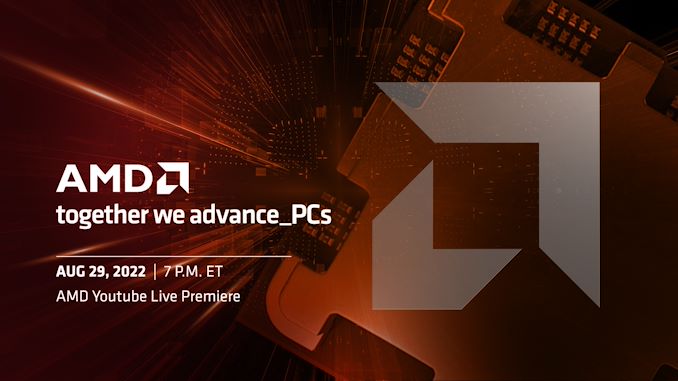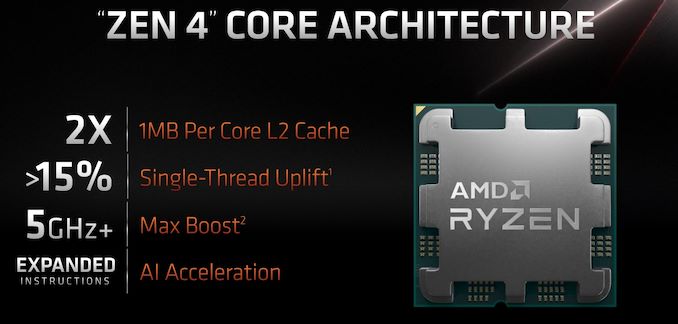AMD Announces Ryzen 7000 Reveal Livestream for August 29th
by Ryan Smith on August 16, 2022 2:25 PM EST- Posted in
- CPUs
- AMD
- Zen 4
- AM5
- Ryzen 7000

In a brief press release sent out this morning, AMD has announced that they will be delivering their eagerly anticipated Ryzen 7000 unveiling later this month as a live stream. In an event dubbed “together we advance_PCs”, AMD will be discussing the forthcoming Ryzen 7000 series processors as well as the underlying Zen 4 architecture and associated AM5 platform – laying the groundwork ahead of AMD’s planned fall launch for the Ryzen 7000 platform. The event is set to kick off on August 29th at 7pm ET (23:00 UTC), with CEO Dr. Lisa Su and CTO Mark Papermaster slated to present.
AMD first unveiled their Ryzen 7000 platform and branding back at Computex 2022, offering quite a few high-level details on the forthcoming consumer processor platform while stating it would be launching in the fall. The new CPU family will feature up to 16 Zen 4 cores using TSMC's optimized 5 nm manufacturing process for the Core Complex Die (CCD), and TSMC’s 6nm process for the I/O Die (IOD). AMD has not disclosed a great deal about the Zen 4 architecture itself, though their Computex presentation has indicated we should expect a several percent increase in IPC, along with a further several percent increase in peak clockspeeds, allowing for a 15%+ increase in single-threaded performance.
The Ryzen 7000 series is also notable for being the first of AMD’s chiplet-based CPUs to integrate a GPU – in this case embedding it in the IOD. The modest GPU allows for AMD’s CPUs to supply their own graphics, eliminating the need for a discrete GPU just to boot a system while, we expect, providing enough performance for basic desktop work.
| AMD Desktop CPU Generations | |||
| AnandTech | Ryzen 7000 (Raphael) |
Ryzen 5000 (Vermeer) |
Ryzen 3000 (Matisse) |
| CPU Architecture | Zen 4 | Zen 3 | Zen 2 |
| CPU Cores | Up To 16C / 32T | Up To 16C / 32T | Up To 16C / 32T |
| GPU Architecture | RDNA2 | N/A | N/A |
| GPU Cores | TBD | N/A | N/A |
| Memory | DDR5 | DDR4 | DDR4 |
| Platform | AM5 | AM4 | AM4 |
| CPU PCIe Lanes | 24x PCIe 5.0 | 24x PCIe 4.0 | 24x PCIe 4.0 |
| Manufacturing Process | CCD: TSMC N5 IOD: TSMC N6 |
CCD: TSMC N7 IOD: GloFo 12nm |
CCD: TSMC N7 IOD: GloFo 12nm |
The new CPU family will also come with a new socket and motherboard platform, which AMD is dubbing AM5. The first significant socket update for AMD in six years will bring with it a slew of changes and new features, including a switch to an LGA-style socket (LGA1718) and support for DDR5 memory. Providing the back-end for AM5 will be AMD’s 600 series chipsets, with AMD set to release both enthusiast and mainstream chipsets. PCIe 5.0 will also be supported by the platform, but in the interest of keeping motherboard prices in check, it is not a mandatory motherboard feature.
The remaining major disclosures that AMD hasn’t made – and which we’re expecting to see at their next event – will be around the Zen 4 architecture itself, as well as information on specific Ryzen 7000 SKUs. Pricing information is likely not in the cards (the industry has developed a strong tendency to announce prices at the last minute), but at the very least we should have an idea of how many cores to expect on the various SKUs, as well as where the official TDPs will land in this generation given AM5’s greater power limits.
Meanwhile, AMD’s press release does not mention whether the presentation will be recorded or live. Like most tech companies, AMD switched to pre-recorded presentations due to the outbreak of COVID-19, which in turn has been paying dividends in the form of breezier and more focused presentations with higher production values. While relatively insignificant in the big picture of things, it will be interesting to see whether AMD is going back to live presentations for consumer product unveils such as this.
In any case, we’ll find out more during AMD’s broadcast. The presentation is slated to air on August 29th at 7pm Eastern, on AMD’s YouTube channel. And of course, be sure to check out AnandTech for a full rundown and analysis of AMD’s announcements.
Source: AMD











52 Comments
View All Comments
shabby - Tuesday, August 16, 2022 - link
One can only hope, 1gbps ports need to die a quick death. It's the slowest port on a mobo now.ballsystemlord - Tuesday, August 16, 2022 - link
But most Americans do not even have 1/2 Gb speed internet. So there's no point. :cry:ballsystemlord - Tuesday, August 16, 2022 - link
Yes, there's an actual US Gov report that says this.abufrejoval - Wednesday, August 17, 2022 - link
Not all traffic is North-South, there are people with LANs.I've had 10Gbit networking even in my home-lab for 10 years and only got Gbit Internet last year.
shabby - Wednesday, August 17, 2022 - link
Have you heard of home networking?Qasar - Tuesday, August 16, 2022 - link
unless 2.5+ gig switches become less expensive, and more widely available, this is probably not going to happen any time soonabufrejoval - Wednesday, August 17, 2022 - link
There are 8-port NBase-T switches capable of 1/2.5/5/10Gbit available for €350 with taxes, e.g. from Netgear and TP-Link......as globally as Amazon and just a click away.
I have a Buffalo 12-port that's no longer sold and a NetGear 8-port that also comes in a 5-port variant. I resorted to Noctua fans to make the Buffalo 'home-lab compatible', the NetGear was easy on the ears from the start.
10GBase-T started at around 10 Watts power consumption per port 10 years ago, because the modulation required on the copper wires to push that bandwidth was at a similar level of complexity as the last generation of telephone modems. But with NBase-T and Green Ethernet efforts that's been pushed down to around 3 Watts on active ports for 10Gbit/s, much less for 2.5Gbit/s. The result is switches that have a fan just in case someone is pushing 10Gbit/s on all ports without any Green Ethernet, that will remain silent or inaudible most of the time.
~€50/port is obviously more than Gbit-switches today, but those have just become dirt cheap.
And it's still less than 50% per port of what a 10Gbit add-on NIC will cost you. Once switch port cost sink below NIC cost, you should stop complain about switch cost. I know that wasn't the case for years, but please note that the tide has changed.
Of course, I don't expect that an Aquantia ACQ113 on-board chip will cost anywhere near the €90 they are still charging for its ACQ107 predecessor add-in NIC.
I believe RealTek 2.5Gbit NICs are about €1 in volume yet sell at €25 in their USB3 incarnation: there is a significant overhead for any SKU and packaging a NIC, which is why it's so infuriating they don't just add the ACQ113 and be done with it: it will just handle anything from 100Mbit to 10Gbit and has great support on all operating systems.
Something that no longer applies to anything Intel is selling in the 1-10Gbit Ethernet space today: they have moved as far away from 'one driver for all' as you can imagine in your worst nightmares.
And it doesn't even buy you features for virtualization or relevant offload engines... I can't think of any reason why anyone would chose an Intel i225 over an ACQ113 on technical merits alone.
Qasar - Wednesday, August 17, 2022 - link
never seen those switches for sale here, the only switches i have been able to find here that are 2.5gig or faster, are a minimum of $800 and i think it was only a 5 port. i would need at least 8 ports. or they are SFP+ based, which adds to the cost over all.spamaway - Thursday, August 18, 2022 - link
Take a look at what Mikrotik sells. Their CRS309-1G-8S+IN is passively cooled, has eight SFP+ cages, and has an MSRP of 269 USD. The CRS305-1G-4S+IN is also passively cooled, has four SFP+ cages, and an MSRP of 149 USD.I have been using several of their CRS326-24G-2S+IN switches for months now, and they work great. I highly recommend buying their hardware.
Qasar - Thursday, August 18, 2022 - link
never heard of that one. and needs sfp+ so same with the ones here, thats adds to the cost.